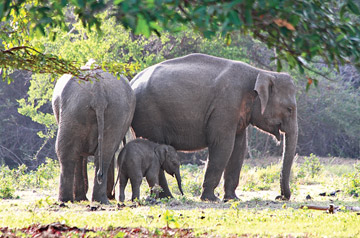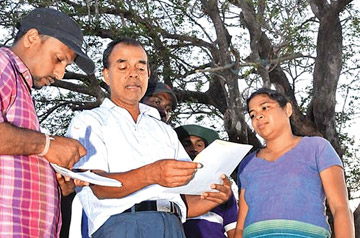|

First ever National Elephant Survey:
Elephant boom in North
By Dhaneshi YATAWARA
|

Elephants in the forests of Vavuniya
|
The results of the first ever National Elephant Survey is currently
undergoing a close scrutiny at the Statistics Department of the
Peradeniya University. The Department of Wildlife Conservation expects
to issue an interim report as the initial step and later a complete
survey.
Sri Lankan Elephant (Elephas maximus maximus), is a sub species of
the Asian elephant (Elephas maximus). The 53,000 Asian Elephants live in
13 countries in the world whereas its counterpart the 600,000 African
Elephants ('Loxodonta africana') live in 37 countries. Among this highly
dense elephant population Sri Lankan elephants estimated to be 10% of
the world population. According to the historical documents available
with the Department of Wildlife Conservation (DWC) the first numbers are
recorded from 1900s. Accordingly it is believed that in the early 20th
century there could have been approximately 10,000 elephants roaming on
this island.
In 1951 the elephant count had been between 1,000 - 1,500 (Norris,
1959). According to DWC administration reports in 1954 the number had
been 900 and in 1956 it has dropped to 750 - 800. Again in 1959 the
elephant number rises to 1626 (Norris, 1959).
The first survey, more in the nature of a census, conducted by the
Department of Wildlife Conservation was in 1993. In this the DWC carried
out the survey only in five wildlife regions including the Northwestern,
Mahaweli, Eastern and the Southern regions.

Manjula Amararathne |

H.D. Ratnayake |
The total count was 1967. Second count took place in the Northwestern
wildlife region in 2004 in which elephants in Kurunegala, Puttalam,
Anuradhapura, Mannar and Vavuniya districts and in the Wilpattu National
Park were counted.
Accordingly in the Wilpattu 51 elephants were counted, 143 elephants
in the Kurunegala district, 198 in the Puttalam district, 613 in the
Anuradhapura district, 71 in the Vavuniya district and 220 in the Mannar
district. The third was in the Mahaweli wildlife region in 2008 which
showed a 2149 elephant population in the region.
None of the surveys were able to give a clear picture of the nature
of the Sri Lankan elephant population. Yet, none of the surveys were
able to give an idea on the population trend, distribution pattern,
heavily and moderately used areas of the elephants and abundance of
tuskers.
The North could be the most neglected area among all the regions
across the country in the previous elephant surveys. Out of the total
1553 observation points located countrywide 162 were in the Northern
wildlife region.
As peace and safety returned to the Northern Province the Wildlife
authorities were able to comb the jungles looking for jumbo herds those
were not properly identified for nearly two decades. Particularly
Mullaitivu and Kilinochchi were out of reach.
The Northern elephant population can only be figured following the
end of the analysis. "Unfortunately, it is more difficult to count
elephants in a forest than fish in a pond!" states Professor Charles
Santhiapillai - a leading elephant expert involved in the survey - in
one of his earlier papers named 'Counting elephants in wild'. Thus the
wildlife authorities had to establish a method for proper observation,
an accurate counting and analysis system. "The observation part of the
survey had a smooth run, particularly considering the weather in many
parts of the country.
It really did not hamper our mission," said H.D. Ratnayake, Director
General DWC. The water hole counting method fits perfectly to the usual
dry weather of this part of the year.
|

DWC’s Deputy Director (Research and Training) S.R.B. Dissanayake
enlightens observers |
"We fixed a day close to Poya since the moon shines bright during
this period. And even in the night we can observe the elephant
behavioural patterns," said DWC's Deputy Director for Research and
Training S.R.B. Dissanayake.
This was more of a survey of Sri Lankan elephants, rather a count,
Dissanayake said. Elephants could be mistakenly recounted or would be
miscounted as the subjective area is large.
"These errors will be corrected during the analysis at the Statistics
Department of the Peradeniya University," Dissanayake added.
For the survey in the Northern Province the Sri Lanka Army extended
their helping hand as a majority of the people in the North have just
resettled or still resettling.
Along with the wildlife officials, soldiers of the Army searched the
wilderness of the North for elephants in the three-day survey. According
to Manjula Amararathne, Deputy Director of the DWC in charge of the
Northern Province survey, their discoveries in the Northern unsearched
lands are significant.
"There are considerable number of elephants observed in the North yet
it is too early to give a conclusion," he added.
"We decided on the observation points after discussing with the
villagers now settled in the area as well as with the army personnel.
Yet the pattern of elephant movements were different at certain points
especially in Mullaitivu, Kilinochchi and Vavuniya North and we had to
make changes," Amararathne added.
For example the villagers would say the elephants were frequently
seen but during the counting sessions the elephants may go to the next
closest water hole. "That is the nature of wildlife," he said.
Yet the elephants rarely altered their daily routine unless more
water resources become available in the other parts of the forests,
especially due to rain.
Evidence of elephants' presence in the jungles were abundant,
especially near tanks and ponds. Elephant dung, foot marks, broken trees
and crushed grass were a common sight during the jungle tour.
The low country Dry Zone which is the last bastion of the elephant in
Sri Lanka is dotted with thousands of man-made irrigation reservoirs or
tanks.
These tanks and their associated grasslands provide excellent habitat
for elephants and raise the carrying capacity, said Professor Charles
Santiapillai. Commenting on the present survey Prof. Santiapillai said
it is a truly gargantuan task for the DWC.
"This is also the first time, the DWC has enlisted the services of an
experienced Statistician from the University of Peradeniya to analyze
the data so that errors due to double counting of elephants could be
reduced as much as possible. In addition to the observers placed at
these observation points, the DWC also used a number of mobile patrols
to cover large areas.
Therefore the present survey is an improvement on the earlier ones
carried out in 1993, 2004 and 2008," he added. As he explained the key
to success is being honest with the recording of the data. "As long as
the observers record faithfully what they see and not what they imagine,
the analysis of the data will be enormously rewarding.
However, when you employ a variety of people, with different
educational background to classify elephants according to sex and age,
errors are inevitable," said Prof. Santiapillai. Hence it is important
that we discard dubious data and concentrate on what appears to be the
most plausible and reliable information. As Prof. Santiapillai further
explained this survey was planned to get information on the population
structure and composition; it was not meant to be a census of elephants.
"The latter is almost impossible in Sri Lanka (& elsewhere in Asia)
given the dense and tangled nature of the vegetation," he explained.
As Prof. Santiapillai explains, ecologically elephants are dominant
herbivores that often have a more profound effect on ecosystem dynamics
than top predators such as the lion, leopard or tiger. "High population
densities of elephants have a cascading effect leading to a reduction in
biological diversity.
Thus in areas where the forest cover is low, and human population
density is high, elephants often come into conflict with man.
It is a truism that at any but the lowest density, large wild animals
and humans are fundamentally incompatible.
This incompatibility increases rapidly as both animal and human
densities increase.
This is happening today in Sri Lanka," he said. Considering past
statistics the Department of Wildlife Conservation (DWC) has spent more
than 50 percent of its working time and allocated budget to mitigate
human-elephant conflict (HEC). In order to bring a sustainable solution
to the Human-Elephant Conflict knowing the numbers (of elephants) is
crucial.
As Prof. Santiapillai continued to explain, to succeed in elephant
conservation, we need to convert the agricultural pest into an economic
asset. The human-elephant conflict in Sri Lanka is intense and leads in
only one direction: the destruction and eventual elimination of
elephants from areas of high conflict, unless people can be persuaded to
share their land and their resources with the elephants. The DWC also
needs to address the legitimate concerns and aspirations of the poor
people who bear the brunt of elephant depredation almost on a daily
basis. "The HEC is not simply a wildlife problem, it is also an
agricultural problem, and hence it is not fair to blame the DWC every
time an elephant is killed by irate farmers.
The two Departments need to work together to seek solutions," Prof.
Santiapillai added. He also said that considering the high density of
elephants in Sri Lanka compared to other countries of the region is a
sign of great work of the DWC.
Sri Lanka has a viable elephant population. It sustains almost 10% of
the global Asian elephant population, despite its small size and dense
human population, said Prof. Santiapillai. "No other country in Asia
offers such rich and diverse habitat for elephants. Elephants, given
protection and access to food, water and cover, would increase. The
Accelerated Mahaweli Development Programme too has created conditions
that promote elephant population growth: year round availability of
water and access to cultivated crops that are nutritionally far superior
to the forest vegetation. The low country Dry Zone, with thousands of
man-made irrigation reservoirs or tanks and its grasslands provide
excellent habitat for elephants and raise the carrying capacity," he
explained the present situation the Sri Lankan elephant population is
facing. Thus the long-term survival prospects for the elephant in Sri
Lanka are good provided we control or minimize the human-elephant
conflict.
Conserving the magnificent Megaherbivore such as the elephant in Sri
Lanka is inextricably linked to the welfare of the people with whom the
animal shares the land. Elephant and other wildlife management practices
must be carried out as though people matter. "We need to encourage the
development of a symbiotic relationship between man and elephant.
Wildlife is a sustainable natural resource. Some argue that all
wildlife must be simply protected and not exploited. Others, including
me, believe that it is only by allowing people who live in and around
areas frequented by wildlife to derive economic benefit from it that
they can be led to appreciate the value of wildlife and thus become
committed to conserving it," said Prof. Santiapillai explaining the
options left for Sri Lanka to mitigate Human-elephant conflict.
|

